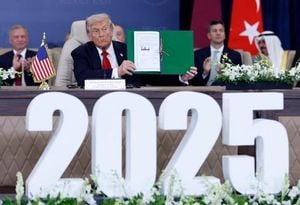As 2025 draws to a close, the economic outlook for the Americas is a patchwork of resilience, caution, and mounting uncertainty. On both sides of the equator, policymakers, analysts, and business leaders are keeping a wary eye on inflation, global trade headwinds, and the ever-present specter of political disruption. From the corridors of Washington, D.C., to the bustling capitals of Latin America and the sun-soaked islands of the Caribbean, the challenges and opportunities are as diverse as the region itself.
In a recent interview with Quartz, former U.S. Treasury Secretary Larry Summers—who famously predicted the post-pandemic inflation surge—voiced renewed concerns about the direction of the U.S. economy. “I am, if anything, a bit more worried about inflation than I am about recession, given the strength of most categories of consumption spending, most categories of business investment and the relatively expansionary posture of monetary and fiscal policy and some signs of rising inflation expectations. I think the greater risks are on that side,” Summers said.
This perspective comes at a time when the U.S. economy has shown remarkable resilience despite a host of disruptive policies. According to Summers, the labor market is showing signs of weakening, but he attributes much of this to a reduced labor supply—particularly due to recent border policies—rather than a drop in labor demand. “I certainly see that the labor market is weakening,” he noted. “But some of that has to do with reduced labor supply associated with border policies, rather than reduced labor demand.”
Summers also sounded the alarm about the U.S. moving toward a style of economic populism more commonly seen in Latin America, a trend he finds deeply troubling. “For much of my career, I have been commenting on how important it would be, and how valuable it would be, if Latin American countries became more like the United States in terms of having secure transfers of power at elections, independent judiciaries, fiscally prudent budget policies, independent central banks, economies [relatively] open to the rest of the world. ... And until quite recently, I had not really contemplated the possibility of convergence in the other direction, with the United States becoming more like Latin America. That is, to my mind, a troubling prospect, made more troubling by the fact that the United States, unlike any of the countries in Latin America, is a superpower with major global responsibilities.”
Meanwhile, the International Monetary Fund (IMF) released its latest projections for Latin America and the Caribbean, painting a picture of steady, if unspectacular, growth. The region is expected to grow by 2.4% in 2025, with a slight dip to 2.3% in 2026, according to Rodrigo Valdés, director of the IMF’s Western Hemisphere department. “Despite the uncertainty, global conditions have been broadly supportive for the region,” Valdés told reporters in Washington, D.C. Commodity prices have stabilized, financial conditions have eased, and key regional exports—such as copper and manufactured goods from Chile and Mexico—have kept pace with global trends.
Labor markets across Latin America and the Caribbean remain robust, generally supporting private consumption. This resilience has been aided in part by U.S. tariff policies, which have been less restrictive in the region compared to other parts of the world. While countries like Brazil and Mexico have felt some pinch from tariffs, the Caribbean has largely been spared, thanks to exemptions on a significant portion of its exports to the U.S.
Still, the region faces its own set of challenges. The IMF report highlights the persistent issue of low productivity, which continues to weigh on growth prospects. Even when countries excel in certain sectors, such as Argentina’s strong agricultural output or Venezuela’s oil production—which currently stands at about one million barrels a day—broader economic gains have been elusive. Venezuela, for instance, is forecast to see its growth slow to just 0.5% this year amid ongoing macroeconomic and political turmoil. The country’s deep crisis has already forced approximately eight million people, or a quarter of its population, to flee since 2014.
Remittances—a lifeline for many economies in the region—have shown mixed trends. “Remittances have been behaving very well in Central America,” Valdés said. “In Mexico, we have seen more sluggish or even dropping remittances.” He cautioned that these flows are not always persistent, with many being “one-offs” rather than a steady stream. The U.S. labor market’s current lack of openness to new immigrant workers is expected to further dampen remittance growth, a concern for families across Central America and the Caribbean.
While most Caribbean economies are projected to grow by 1.9% this year and next—buoyed by tourism, construction, and a rebound from last year’s storm-related setbacks—there are dramatic exceptions. Guyana stands out, with oil drilling fueling what the IMF calls “exceptionally strong growth.” The country’s economy expanded by a staggering 43.6% last year and is projected to grow by 10.3% in 2025 and 23% in 2026. At the other extreme, Haiti is mired in crisis, facing its seventh straight year of economic contraction. Gang violence, the expiration of Temporary Protected Status for Haitians in the U.S. in February 2026, and the end of preferential trade access for textiles and apparel are all exacerbating the country’s woes. Haiti’s economy is expected to shrink by 3.1% this year and another 1.2% next year.
Inflation remains a persistent concern throughout the region. The IMF projects inflation in the Caribbean will rise to 6.9% in 2025 before easing the following year. This uptick is being driven by higher import prices and the effects of U.S. currency depreciation, especially in countries with currencies pegged to the dollar. The Fund warns that the Caribbean’s geographic isolation and dependence on imports make its economies particularly vulnerable to inflationary shocks from changes in trade policy and supply chain disruptions. “Global policy uncertainties also underscore the need for stronger policy buffers,” the IMF report emphasized, noting that while some Caribbean countries have made progress in reducing their debt-to-GDP ratios since the pandemic, public debt remains high—limiting their ability to respond to external shocks.
Back in the United States, Summers called on business leaders to be more proactive in addressing what he sees as self-inflicted threats to economic growth. He likened some recent trends in U.S. policy—such as government interventions in business and attacks on the Federal Reserve—to the populist playbook often seen in Latin America, warning that such moves could undermine the country’s long-term prosperity and global leadership.
As both regions navigate this uncertain landscape, the interplay between policy choices, global economic forces, and local realities will continue to shape the fortunes of millions. Whether the Americas can chart a course toward greater stability and shared prosperity—or risk sliding into deeper volatility—remains the central question facing leaders and citizens alike as 2026 approaches.





